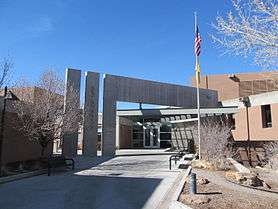University of New Mexico School of Law
The University of New Mexico School of Law is the law school of the University of New Mexico, located in Albuquerque. It is the only law school in the state of New Mexico. Approximately 350 students attend the school, with approximately 115 enrolled in the first-year class. By design, the school has remained this size in order to provide students more hands-on learning and individual attention from professors.[5] Its student-to-faculty ratio of 10.0 is one of the best in the nation.[6] It also has one of the highest student diversity indexes of any law school in the country, with Hispanics as the largest minority group.[7] The National Jurist legal magazine ranked UNM the 6th Best Value among law schools, a ranking based on several criteria including students' average indebtedness after graduation, student employment rates, and tuition costs.[8]
| University of New Mexico School of Law | |
|---|---|
 | |
| Established | 1947 |
| School type | Public |
| Dean | Alfred D. Mathewson and Sergio Pareja |
| Location | Albuquerque, New Mexico, U.S. |
| Enrollment | 347[1] |
| Faculty | 34[2] (full time) |
| USNWR ranking | 91[3] |
| Bar pass rate | 92%[4] |
| Website | lawschool |
| ABA profile | UNM School of Law Profile |

The school is currently ranked 60th by U.S. News & World Report and boasts the 11th ranked Clinical Training program in the country.[9] UNM Law School is one of only 80 law schools nationwide to have a chapter of the Order of the Coif. According to New Mexico's official 2013 ABA-required disclosures, 72.8% of the Class of 2013 obtained full-time, long-term, JD-required employment nine months after graduation.[10]
Academics
Notable programs
Highly regarded educational programs at the law school include clinical education, Indian law, and natural resources and environmental law. The in-house Clinical Law Program has been consistently recognized as among the country’s best. Though clinical education is optional at most law schools, participation in the clinic is required of all UNM law students.[11] The Indian Law Program includes a specialized program of study leading to a certificate in Indian Law, the Southwest Indian Law Clinic, and the faculty-edited Tribal Law Journal. The Natural Resources and Environmental Law Program includes a specialized program of study leading to a certificate in the field and the student-edited Natural Resources Journal.
The School of Law has a unique relationship with the state government. Under the terms of the Constitution, the Dean of the School of Law has the responsibility of chairing the state's judicial selection process. The Dean also has the statutory responsibility of chairing the state's Judicial Compensation Commission and serving on other boards, committees and commissions. Moreover, the School of Law has the primary responsibility for all judicial education within the state.
Exchange and study abroad programs
Study abroad opportunities are available with special UNM exchange programs in Mexico, Canada, and Tasmania. The law school also has an exchange program with the University of New Hampshire School of Law, which allows UNM students to study patent and intellectual property law at that school.[12]
Admissions
The School of Law describes its admissions process as follows: A five-member Admissions Committee reviews all applications and makes final decisions on acceptance for admission into the next fall’s entering class. The Committee is three full-time faculty members, the Assistant Dean for Admissions, and one third-year law student elected by the student body. The Committee begins reviewing files near the end of the Fall semester; but often a final decision is not made until late April. Th ecommittee considers quantifiable factors (LSAT and grade point average) and non-quantifiable factors (letters of recommendation, personal statement, and extracurricular activities) in making decisions. A substantial preference is given to New Mexico residents. The committee also recognizes that special pre-law programs for minority and disadvantaged applicants provide valuable information about an applicant’s ability to succeed in law school, and participation in such programs is taken into account.[13]
Centers and institutes
- American Indian Law Center, Inc.: an independent center based at the law school that is the oldest existing Indian-controlled and operated legal and public policy organization in the country
- Guanajuato Summer Law Institute:
- UNM Mediation Training:
- UNM Institute of Public Law: a think tank devoted to the development of informed public policy and law for the state of New Mexico.
- The Utton Transboundary Resources Center: a center specializing in transboundary resource disputes
- Pre-law Summer Institute: an intensive two-month program run by the AILC at the law school, which prepares American Indian and Alaska Native individuals for the rigors of law school by essentially replicating the first semester of law school.
Publications
- Natural Resources Journal
- New Mexico Law Review
- Tribal Law Journal
- United States–Mexico Law Journal (1993-2005)
Competitions and Moot Courts
Students may participate in the following competitions and moot courts at the law school:
- ABA Negotiation Competition
- American Intellectual Property Moot Court Competition
- Animal Law Moot Court Competition
- Environmental Moot Court Competition
- Health Law Moot Court Competition
- Hispanic National Bar Association Moot Court Competition
- Jessup International Moot Court Competition
- National Mock Trial Competition
- National Moot Court Competition
- National Native American Moot Court Competition [14]
Campus
In 1971, the law school moved into its current building, designed by the architect Antoine Predock while he was working for George Wright & Associates.[15] In 2002, the law school opened the Fred Hart wing, designed by architect Edward Mazria.[16][17] The New Mexico Court of Appeals is located on campus, next door to the School of Law. The Court of Appeals and the School of Law have a symbiotic relationship with the judges using the law school's library and the students using the Court of Appeal's formal courtroom. Indeed, the Court of Appeals was designed for this use, with classrooms for law students adjacent to the formal courtroom.[18]
Employment
According to New Mexico's official 2013 ABA-required disclosures, 72.8% of the Class of 2013 obtained full-time, long-term, JD-required employment nine months after graduation.[19] New Mexico's Law School Transparency under-employment score is 23.7%, indicating the percentage of the Class of 2013 unemployed, pursuing an additional degree, or working in a non-professional, short-term, or part-time job nine months after graduation.[20]
Costs
Tuition cost for a full time in-state student, i.e. tuition and fees but not including living expenses, for the 2018-2019 academic year was $8674.76 per semester, or $17,349.52 total for the academic year. Tuition cost for a part time in-state student, taking 10 credits per semester, for the 2018-2019 academic year was $7274.80 per semester, or $14549.60 per academic year. The total cost of attendance (indicating the cost of tuition, fees, and living expenses) at New Mexico for the 2013-2014 academic year was $31,358 or $49,628 for nonresidents.[21] The Law School Transparency estimated debt-financed cost of attendance for three years is $120,833 for residents or $192,655 for non-residents.[22]
Notable alumni
- Article III Federal Judges
- Joel M. Carson III (Class of 1997), Circuit Judge, United States Court of Appeals for the Tenth Circuit, nominated by Donald Trump
- Curtis LeRoy Hansen (Class of 1961), Senior Judge, U.S. District Court of New Mexico, nominated by George H.W. Bush
- Jimmie V. Reyna (Class of 1978), Circuit Judge, United States Court of Appeals for the Federal Circuit, nominated by Barack H. Obama
- M. Christina Armijo (Class of 1975), Senior Judge, U.S. District Court of New Mexico, nominated by George W. Bush
- Robert C. Brack (Class of 1978), Judge, U.S. District Court of New Mexico, nominated by George W. Bush
- Ramona Villagomez Manglona (Class of 1996), Chief Judge, U.S. District Court for the Northern Mariana Islands, nominated by Barack H. Obama
- Kenneth J. Gonzales (Class of 1994), Judge, U.S. District Court of New Mexico, nominated by Barack H. Obama
- Paul W. Grimm (Class of 1976), Judge, U.S. District Court of Maryland, nominated by Barack H. Obama
- Politicians and Government Officials
- Hector Balderas, New Mexico State Auditor and former State Representative. (Class of 2001)
- Charles W. Blackwell, first Ambassador of the Chickasaw Nation to the United States from 1995 until 2013, (Class of 1972)[23]
- Paul Bloom (1939–2009), lawyer who recovered $6 billion for the United States Department of Energy.[24]
- Brian Colon (Class of 2001)
- John EchoHawk, founder of Native American Rights Fund (NARF), (Class of 1970)
- David Iglesias (Class of 1984)
- Georgene Louis, member of the New Mexico House of Representatives, (Class of 2004)
- Kathleen Kennedy Townsend (Class of 1978)
- Gary King (politician) (Class of 1984)
- Michelle Lujan Grisham (Class of 1987)
- Thomas J. Mabry, Governor of New Mexico, also Chief Judge NM State
- Xochitl Torres Small, U.S. Representative for New Mexico's 2nd congressional district.
- Gloria Tristani, member of the Federal Communications Commission (FCC), 1997-2001.
- Tom Udall (Class of 1977)
- John Wertheim (Class of 1995)
- John Anthony Castro (Class of 2012) Candidate for U.S. Senate
- Steven Schiff (Class of 1972)
- Jonathan Rothschild, Mayor of Tucson, Arizona, (Class of 1977)
- Supreme Court of New Mexico
- Petra Jimenez Maes (Class of 1973)
- Barbara J. Vigil (Class of 1985)
- Edward L. Chavez (Class of 1981)
- Charles W. Daniels (Class of 1969)
- Judith Nakamura (Class of 1989)
- Professors
- Pippa Browde, Professor, University of Montana School of Law
- Placid Gomez, Professor, University of La Verne College of Law.
- Bill Piatt, (Class of 1972), Professor and former Dean, St. Mary's University School of Law
- Fictional
- Kimbery Wexler, main character on the television series Better Call Saul
Notable faculty
- Current
- Christian G. Fritz
- Nathalie Martin
- Kevin K. Washburn
- James W. Ellis
- Former
References
- "Archived copy" (PDF). Archived from the original (PDF) on 2009-12-29. Retrieved 2008-07-30.CS1 maint: archived copy as title (link)
- UNM Law website
- "ABA Data for first time takers in New Mexico, Winter 06 and Summer 07" (PDF). Archived from the original (PDF) on 2009-12-29. Retrieved 2008-07-30.
- "About the University of New Mexico School of Law :: UNM School of Law | The University of New Mexico". lawschool.unm.edu. Retrieved 2015-06-10.
- USNews: America's Best Graduate Schools 2008: Law: New Mexico
- "USNews: America's Best Graduate Schools 2008: Law". Archived from the original on 2009-03-09. Retrieved 2013-11-14.
- "Best Value Law Schools | the National Jurist". www.nationaljurist.com. Retrieved 2015-06-10.
- "Best Law School Rankings | Law Program Rankings | US News". Retrieved 2016-03-17.
- "Consumer Information :: UNM School of Law | The University of New Mexico". lawschool.unm.edu. Retrieved 2015-06-10.
- About the Clinical Program - Clinical Law Programs | UNM School of Law
- http://lawschool.unm.edu/academics/exchange/pierce.php
- About Admissions - Admissions | UNM School of Law
- http://lawschool.unm.edu/curriculum/competitions/descriptions/index.php
- http://lawschool.unm.edu/about/history/index.php
- http://lawschool.unm.edu/about/history/milestones.php
- Unm Law School Earns Merit Award For Building Addition
- Harbert, Nancy (October 1, 2011). "Moot Courtroom Turned into Classroom". UNM Law 2011. Retrieved 13 November 2011.
- "Employment Statistics".
- "New Mexico University Profile".
- "Tuition and Expenses".
- "New Mexico University Profile".
- "Chickasaw Nation Ambassador Charles W. Blackwell – a Man of Vision". KXII. 2013-01-04. Archived from the original on 2013-01-08. Retrieved 2013-01-20.
- Martin, Douglas. "Paul L. Bloom, Who Tackled Overcharging by Oil Companies, Dies at 70", The New York Times, October 13, 2009. Accessed October 27, 2009.